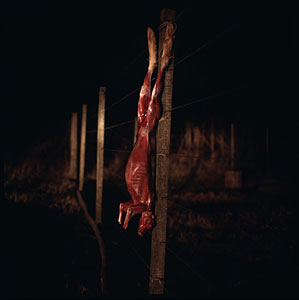Hungry Hyaena: Alessandra Sanguinetti at Yossi Milo Gallery
I saw a selection of photos from Sanguinetti’s series, On the Sixth Day, when I visited New York last month. The exhibition had a powerful emotional impact, but since we were doing a four-hour marathon of Chelsea galleries that day, I didn’t have the time to thoroughly assimilate and analyze my own reactions. Fortunately, Hungry Hyaena reminded me about it with a thoughtful review at his blog.
Perhaps because we share the experience of a rural childhood, his feelings pretty closely mirror my own. My dad was a hunter, and although I never accompanied him, it was understood I would occasionally help to clean and butcher his kills. We ate what he shot: deer, elk, pheasant, quail. I learned that the prerequisite of a hamburger is a death, an event both gory and matter-of-fact.

Alessandra Sanguinetti
Untitled, from On the Sixth Day
Fujiflex Print
1996–2004
Hyaena perceptively states:
Sanguinetti’s photographs are often distressing, to be sure, but there is much value in coming to terms with corporeal truths at an early age. Admiring the picture of a drying skin, hung between two trees, I am reminded of the exhilaration and disgust, experienced concurrently, I felt as I skinned my first animal or gutted my first duck. Those complicated experiences stay with me, even after years of repetition, and I see no connection between them and violent desire.
I completely agree. It may be impossible for viewers without rural experience to see the show in the same way. Their closest referent might be CSI or Law and Order, in which the victim is human, and the butchery purely sadistic. Some of the viewers in the gallery clearly found the show nauseating. But if we choose to eat meat, we don’t have the right to fastidiously ignore its source. I was astonished to find that Sanguinetti took her photos in South America, because they looked so much like the Western United States. But then I realized she is making exactly that point: the intimate relationship between rural life and death doesn’t change much along the axes of time and place.
Sanguinetti’s work is not sensational, not hysterical. It does not glorify killing. Neither does it condemn it, and given the subject matter, that is remarkable. It’s a brutally honest portrayal of a complex issue, and it leaves the moral resolution to the viewer. Among many furious and strident collections I saw in Chelsea, this was exceptionally moving because its restraint left ample space for ambiguity.
The show is now over, but a selection of prints from the exhibition can be viewed at the Yossi Milo Gallery site. The series has also been released as a book, On the Sixth Day(Amazon).

I’m glad you liked the show, too, and it’s nice to hear that someone else shares a perspective similar to my own.
I’ll have to bookmark your blog. I got a kick out ofyour profie, as I, too, work in a laboratory when not in the studio, and know quite a few people who planned to be artists and ended up scientists and vice versa.
All the best.